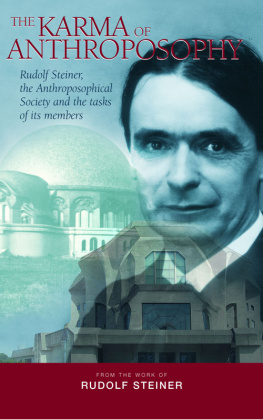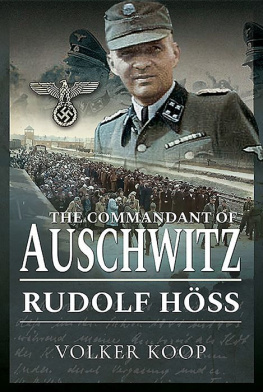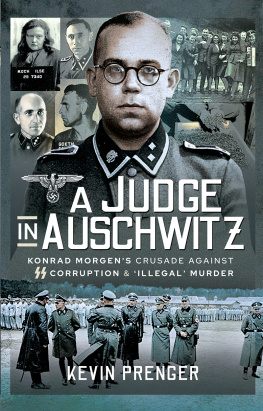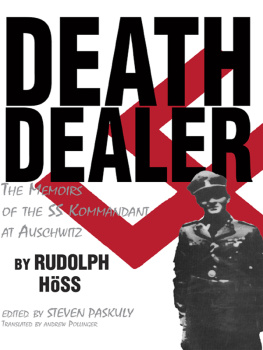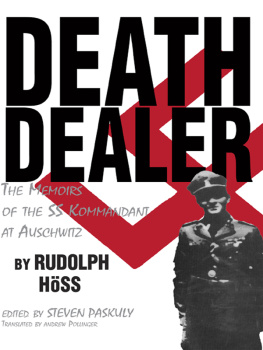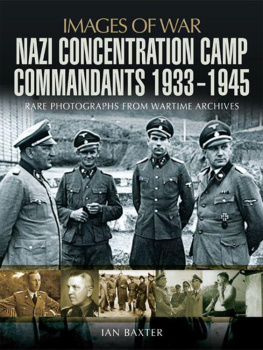COMMANDANT OF AUSCHWITZ
The Autobiography of Rudolf Hoess
with an introduction by Lord Russell of Liverpool, C.B.E., M.C.
translated from the German by Constantino FitzGibbon

Rudolf Hoesss autobiography was first published in a Polish translation in 1951 under the title Wspomnienia by Wydawnictwo Prawnicze, Warsaw. The German text was published in 1958 under the title Kommandant in Auschwitz by the Deutsche Verlags-Anstalt. The English translation was made from this edition. All royalties from this translation go to the Comit International dAuschwitz, a charitable organization set up to help the survivors of the Auschwitz camp; they are a pitifully small proportion of those who passed through its gates.
This autobiography was written in a Polish prison, and for the following facts concerning Hoess and the writing of it I am principally indebted to Dr. Martin Broszat, who wrote the introduction to the German edition.
Hoess was arrested by the British Military Police near Flensburg, in Schleswig-Holstein, on March 11, 1946. He was interrogated by Field Security on March 13 and 14. Later that month he was handed over to the Americans and taken to Nuremberg, where he was again interrogated, in April, in connection with the trial of Kaltenbrunner, the so-called Pohl Trial, and the IG Farben Trial.
During the period April 9-16 he had several conversations with the American prison psychiatrist, Dr. Gilbert.
On May 25, 1946, he was handed over to the Polish authorities and removed to Cracow and later to Warsaw to await trial. The trial did not take place until the following March. He was condemned to death, and executed in April 1947.
What Hoess wrote in prison, the greater part of which is translated and reproduced here, falls into two parts. There is his autobiography, which constitutes pages 29 to 202 and which is given in its entirety so far as it is legible. This was written in January and February of 1947, that is to say, after the preliminary inquiries had been completed, but before he faced trial. The remainder of this book, here given in the form of appendices, was written in connection with that preliminary inquiry or with other inquiries being simultaneously carried out by Dr. Jan Sehn, the examining judge. These documents are of varying interest, and are not all reproduced in full here.
The diary is handwritten and a careful comparison of the handwriting with other documents known to have been written by Hoess, both before and after his arrest, proves its authenticity beyond a shadow of doubt. The other documents are in most cases typewritten, some being stenographic transcriptions, but internal evidence proves them to be certainly genuine as well. The original documents are the property of the High Commission for the Examination of Hitlerite Crimes in Poland (Gloiimej Komisji Badania Zbrodni Hitlerowskich w Polsce), but the Auschwitz Museum made a photostat available to Dr. Broszat, who has fully tested its authenticity.
These documents were first published, in part, in 1951, in a Polish translation edited and introduced by the well-known Polish criminologist, Dr. Stanislaw Batawia, who had had some thirteen conversations with Hoess in Cracow prison, and who had then suggested to him that he write his autobiography. This edition contained all the autobiography and a selection of the other documents. The first complete edition, containing all the documents as well as Hoesss last letters to his wife and children,
The autobiography and the other documents have, as a result of these Polish editions, been known to scholars for many years, and are quoted in most of the books dealing with Nazi atrocities or allied subjects.
But this English translation and the edition being simultaneously printed in Germany, are the first to appear in any language other than Polish. In the German edition the autobiography has been broken up and given chapter headings; but in this English edition it has been considered better to print the text exactly as Hoess wrote it. Furthermore, the German edition is not unabridged. For example, the incident of the Romanian prince has been omitted, presumably for reasons of squeamishness. Here the autobiography is given in its entirety: where there are gaps, indicated by, this is in all cases save one because such brief gaps, all of only a few words, exist in the transcribed typescript and are due to the illegibility of the original manuscript.
The translator would like to express his personal gratitude to Mr. Andrew Foster-Melliar for his help both in preparing the first draft of this translation and in correcting the proofs.
INTRODUCTION
by Lord Russell of Liverpool
The concentration camp system was in full swing within the Third Reich long before the outbreak of the Second World War, and under Himmler its organization had been perfected, and its methods tried out and practiced upon his fellow countrymen in time of peace.
Within a few weeks of his coming to power in 1933, Hitler introduced what was called Schutzhaft, or protective custody, into the legal system. Under it anyone who showed any signs of active opposition to the new regime could be kept under restraint and supervision, and during the next six years thousands of Germans were thrown into concentration camps for what was euphemistically called treatment. Many of them never regained their freedom.
To the Gestapo was entrusted the task of eliminating all enemies of the Party and National State, and it was the activities of that organization that supplied the concentration camps with their inmates, and the SS staffed them.
At the outbreak of war there were six concentration camps in Germany containing about 20,000 prisoners. During the next two years many more were set up, some of which are now household names: Auschwitz, Belsen, Buchenwald, Flossenberg, Mauthausen, Natzweiler, Neuengamme, Ravens-brck, and Sachsenhausen.
During the war probably not less than twelve million men, women, and children from the invaded and occupied territories were done to death by the Germans. At a conservative estimate, eight million of them perished in concentration camps. Of these, not less than five million were Jews. The estimated number given by the Prosecution at the Nuremberg Trial of Major War Criminals was six million. Of subsequent estimates, one was as low as 4,372,000 made by Professor Frumkin, an expert on population changes. Professor Frumkin, however, has publicly stated that this estimate did not include Russia within its present boundaries, and did not take into account some twenty-three million of the population of the Baltic countries, Lithuania, East Prussia, Sub-Carpathia, Bessarabia, Bukovina, and the Polish Eastern Provinces. It would not, therefore, necessarily be an exaggeration to say, wrote Professor Frumkin, that over five million Jews were murdered by the Nazis. The real number, however, will never be known.
Speaking of this terrible holocaust, Sir Hartley Shawcross, now Lord Shawcross, the chief prosecutor for the United Kingdom at the trial of major war criminals in Nuremberg, said in his closing speech, Twelve million murders! Two-thirds of the Jews in Europe exterminated, more than six million of them on the killers own figures. Murder conducted like some mass-production industry in the gas chambers and the ovens of Auschwitz, Dachau, Treblinka, Buchenwald, Mauthausen, Maidanek and Oranienburg.
To these camps were brought millions from the occupied territories; some merely because they were Jews. Some had been deported as slave labor and were no longer considered fit for work. Had the Germans successfully invaded and occupied the British Isles many thousands of British would have been included in this category. Many of the inmates were Russian prisoners of war, some were victims of the Bullet Decree, many were


